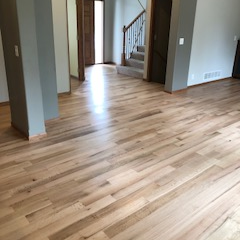Hardwood flooring, with its timeless allure and natural beauty, has been a staple in homes for centuries. Its journey from traditional craftsmanship to modern trends is a fascinating tale that mirrors the evolution of both design and technology.
Let’s delve into the history of hardwood flooring in this blog!
Early Beginnings: Craftsmanship and Tradition
The roots of hardwood flooring trace back to medieval Europe, where wooden planks were handcrafted and installed to provide a durable and visually appealing surface. These early floors were symbols of craftsmanship and a luxury reserved for the wealthy.
Colonial America: Simplicity and Functionality
As European settlers arrived in North America, hardwood floors became more prevalent in colonial homes. Simplicity and functionality were the hallmarks of these early American floors, reflecting the practical needs of the time.
The Industrial Revolution: Mass Production and Accessibility
Steam-Powered Mills and Tongue-and-Groove Innovation
The Industrial Revolution brought about a transformative shift in the production of hardwood flooring. Steam-powered mills enabled mass production, making hardwood floors more accessible to a broader range of homeowners. The introduction of tongue-and-groove installation further simplified the process, allowing for quicker and more efficient installations.
Parquet Patterns and Victorian Elegance
In the Victorian era, parquet flooring became popular, featuring intricate geometric patterns that added an element of elegance to homes. The variety of wood species and designs allowed for a personalized touch, reflecting the homeowner’s taste and status.
Mid-20th Century: Hardwood Resurgence and Design Evolution
Post-War Prosperity and Modern Design
After World War II, with an era of prosperity and the rise of modern design, hardwood flooring experienced a resurgence. Mid-century modern homes favored open spaces and clean lines, and hardwood floors became synonymous with this aesthetic.
The Rise of Engineered Hardwood
In the latter half of the 20th century, engineered hardwood flooring emerged as a practical alternative. Comprising layers of wood bonded together, engineered hardwood offered increased stability and resistance to fluctuations in humidity. This made it suitable for installation in areas where traditional hardwood might struggle, such as basements.
21st Century: Sustainability and Diverse Styles
Sustainability and Eco-Friendly Practices
In recent years, there has been a growing emphasis on sustainability in the hardwood flooring industry. Consumers are increasingly drawn to responsibly sourced and certified wood, and eco-friendly finishes that minimize the environmental impact.
Diverse Styles and Finishes
Modern trends in hardwood flooring showcase a wide array of styles and finishes. From the enduring popularity of wide-plank floors to the sleek and minimalistic look of gray-toned hardwood, homeowners now have a vast selection to choose from, allowing them to align their flooring with current design trends.
Trust Tradition, Embrace Innovation with Husker Hardwood Floors
From the traditional craftsmanship of medieval Europe to the sleek, eco-conscious designs of the 21st century, hardwood flooring has witnessed a remarkable journey.
At Husker Hardwood Floors in Omaha Metro, we honor this rich history while staying at the forefront of modern trends.

Ready to embark on your hardwood flooring journey? Contact Husker Hardwood Floors for expert advice and hardwood floor installation services in Omaha Metro. Our team is dedicated to transforming your space with the enduring beauty of hardwood. Call us today!





